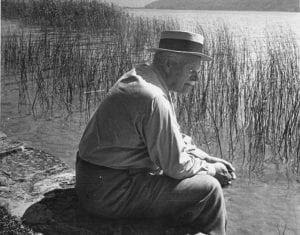Mrs. Crowley: But that is exactly what I meant. I have been mystified all the time you were reading about it.
Dr. Jung: Then women, thou art forgiven!
It is the light of consciousness, but it is a symbol of the consciousness which is not an ego consciousness.
That collective aspect of the city comes from the fact that a city is never one ego alone, but a multitude, so we are confronted with the most tremendous paradox.
The Self means the inmost uniqueness and oneness of this particular being, yet that is symbolized by a city.
This is an early Christian idea also. One finds it in those famous fragments of papyrus dating from the first century A.D., which were excavated at Oxyrhynchus in about 1904.
In a talk between Christ and the disciples, they ask him first how they shall get to the Kingdom of Heaven, and he explains in that wonderful passage about the animals leading them there.
Then he says: "Therefore strive ye to know yourselves and ye shall beaware that ye are the sons of the Father; and ye shall know that ye are in the city of God, and ye are the city."
You see that is absolutely in accordance with the Evangelical teaching that the Kingdom of Heaven is within ourselves.
It is our innermost nature and not in the least what certain theologians want to make of it, something between ourselves.
To say that the Kingdom of Heaven is in between people-like cement-is degenerate theology.
No, it is the entire man, the completeness, the wholeness of an individual, and that is not identical with the ego; the ego is never the Self, it does not include the whole man.
We always suffer from the fact that we are not conscious enough, that we do not cover what is within us.
Why have we neuroses?
The ego consciousness is too narrow.
Whatever that strange non-ego consists of, it is quite certain that our ego consciousness is not sufficient to cover the whole.
So the symbol for the Self is an idea of a totality that is not identical with the ego.
It is a consciousness which is not exactly our consciousness, a light which is not exactly our light.
That agrees with what I said formerly: that these visions are psychological processes which have nothing to do with the conscious ego life.
They are manifestations of the psychological non-ego.
It is a widening out of the ego consciousness into the vision, one might say, of absolute consciousness, or non-individual consciousness, that consciousness which is beyond man.
This sounds terribly abstract or metaphysical, but it is by no means metaphysical.
It simply means the development of a wider and more abstract consciousness, which relates to the other narrower, more concrete consciousness in exactly the same way as algebrarelates to ordinary arithmetic, for instance, or abstract thinking to ordinary matter-of-fact thinking.
So a higher consciousness is a more abstract and impersonal consciousness.
And our patient's vision of the city beyond the giant is an intuition of that consciousness which is beyond the actual ego consciousness, a more complete, a more perfect, a more detached consciousness.
For in the white city, one is surely in a state which is fortified against the surrounding destruction.
The city has always conveyed the idea of a fortified place, surrounded by walls and towers and moats, where inside one is protected.
But I don't want to say any more at this point about the Self as a collective symbol; our text here does not justify us in going so far.
The vision continues: "I said to the giant again: 'I must pass you,' but he only laughed."
Evidently this vision of the white city is not enough to help her.
"While he laughed many dwarfs sprang up from the earth and tore my clothes from me and I was left naked."
Where do the dwarfs suddenly come from?-what do they mean? ~Carl Jung, Visions Seminar, Pages 444-445


No comments:
Post a Comment